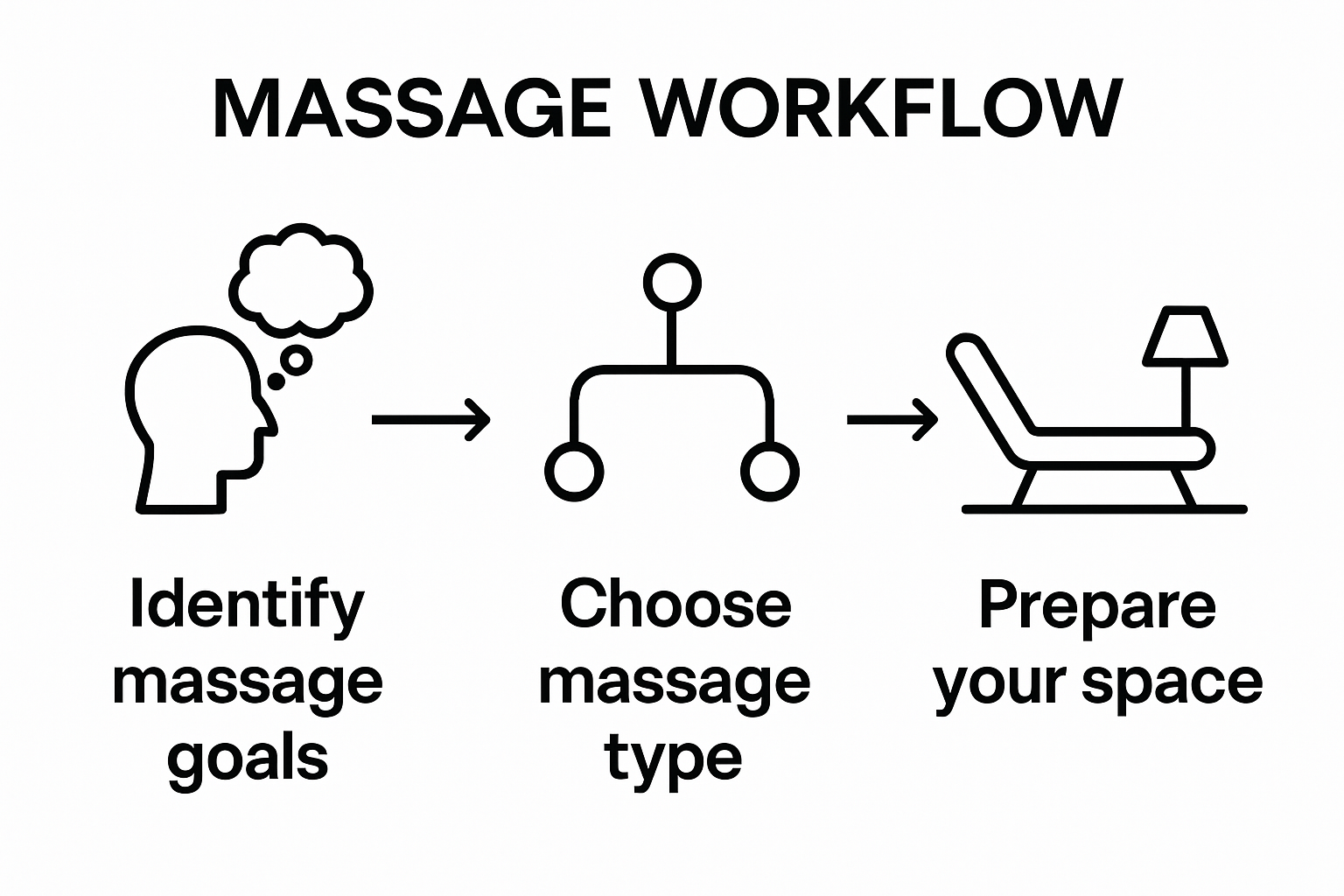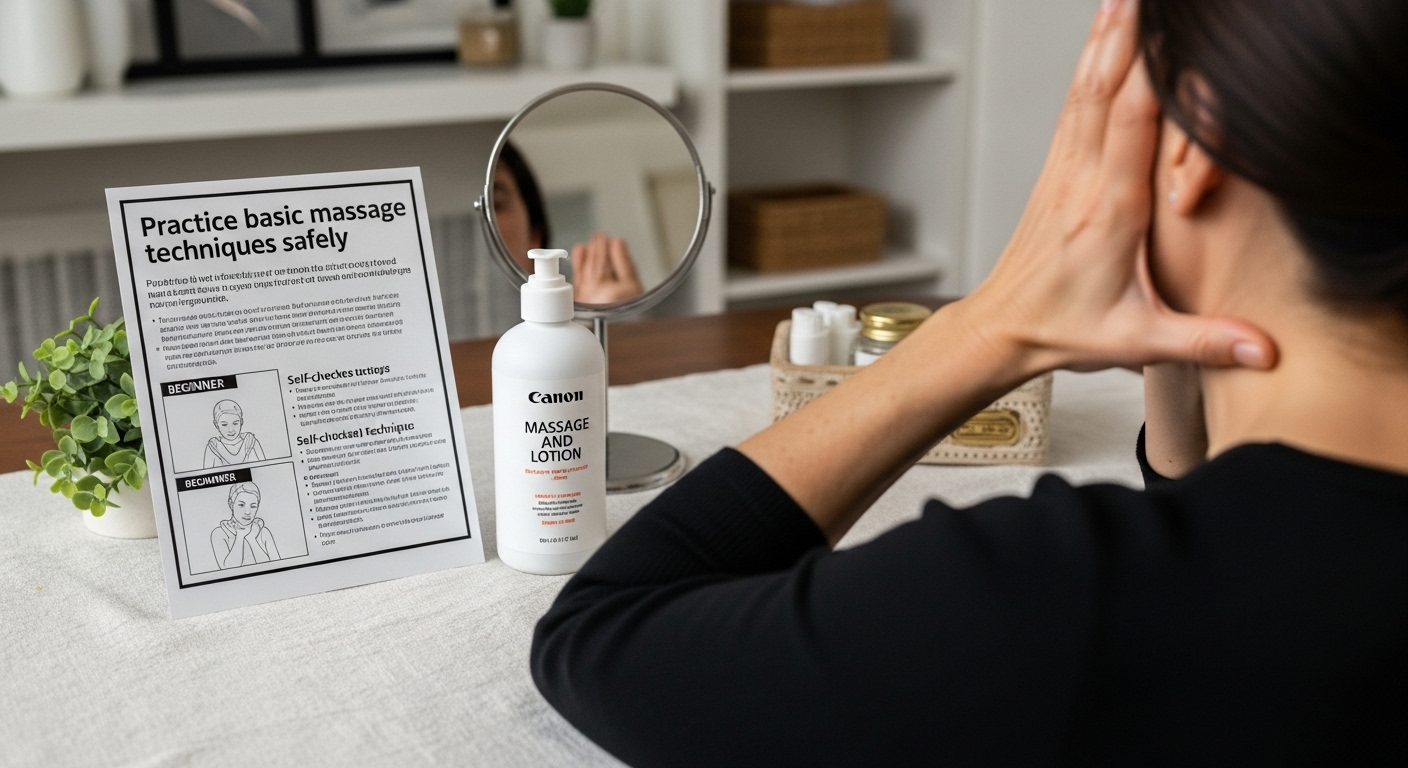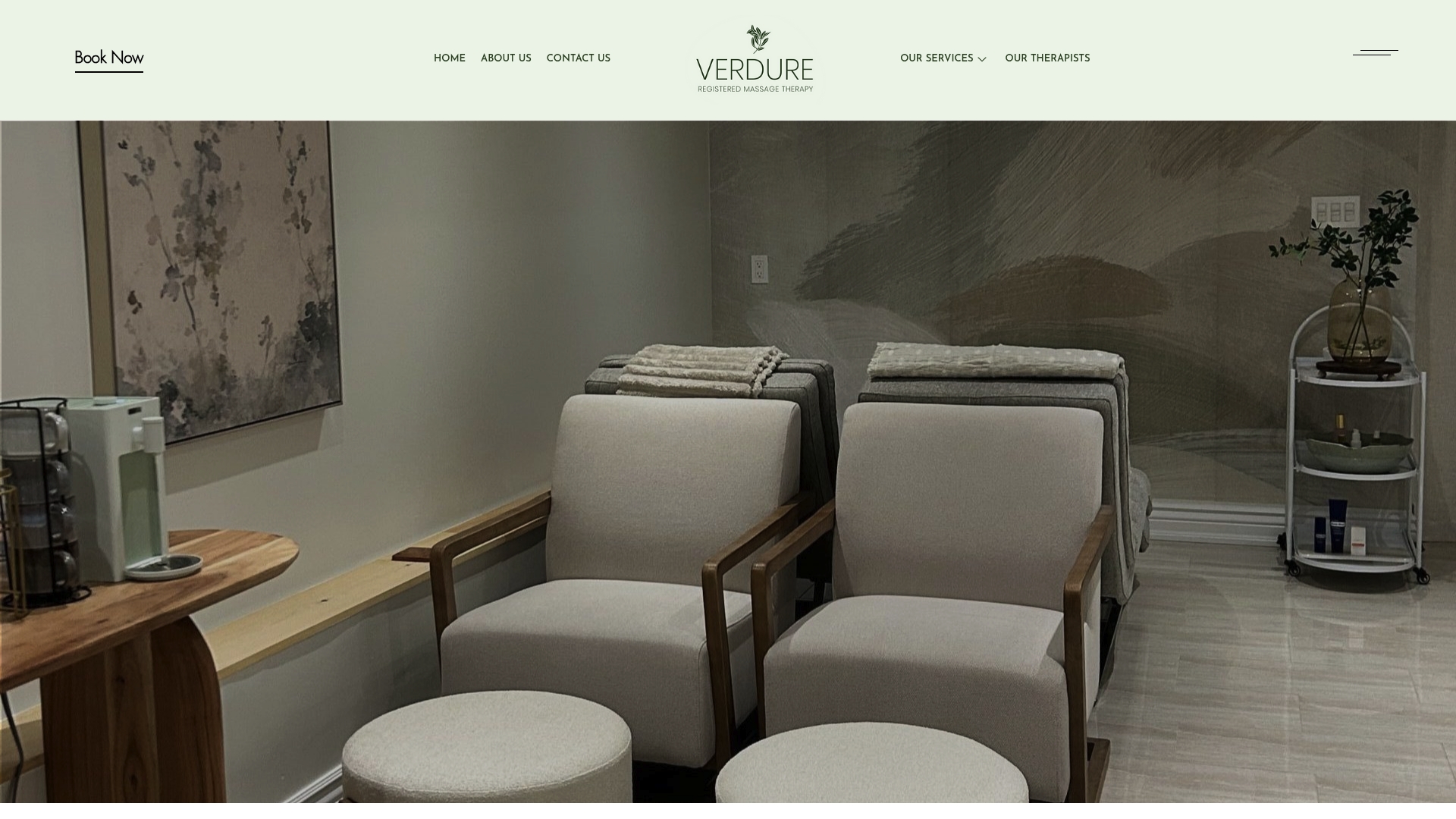Setting clear goals for your massage therapy is more than just a good idea. People who define their wellness targets and communicate them to their therapist are up to 60 percent more likely to see measurable improvements in pain or mobility. Most believe a simple “relaxation” request is enough, but that barely scratches the surface. The real breakthrough comes when you set precise, trackable outcomes and turn every session into a step toward real change.
Table of Contents
- Step 1: Identify Your Massage Therapy Goals
- Step 2: Choose The Right Type Of Massage For Your Needs
- Step 3: Prepare Your Space For A Comfortable Experience
- Step 4: Practice Basic Massage Techniques Safely
- Step 5: Communicate With Your Client For Effective Results
- Step 6: Review And Reflect On Your Session For Improvement
Quick Summary
| Key Point | Explanation |
|---|---|
| 1. Define clear massage therapy goals | Identify specific objectives for your massage therapy to develop a targeted treatment plan. Consider physical and emotional wellness needs. |
| 2. Choose the right massage type | Match your wellness goals with the appropriate massage technique based on your specific physical needs and preferences. |
| 3. Prepare a comfortable environment | Create an optimal setting for your massage by ensuring cleanliness, comfort, and minimal distractions to enhance relaxation. |
| 4. Communicate openly during the session | Build trust and improve outcomes by discussing preferences and comfort levels with your therapist throughout your massage. |
| 5. Reflect on each massage session | Analyze your experiences after each session to refine techniques and better cater to clients’ needs and your own physical performance. |
Step 1: Identify your massage therapy goals
Successful massage therapy begins with crystal clear personal objectives. Understanding what you want to achieve through massage helps your registered massage therapist design a targeted treatment plan that precisely addresses your wellness needs. Your goals could range from stress reduction and muscle tension relief to addressing chronic pain, improving flexibility, or supporting athletic recovery.
Start by conducting an honest self assessment of your current physical and mental state. Consider the specific challenges you’re experiencing: Are you struggling with persistent lower back pain from long office hours? Do you feel constant shoulder tension from work stress? Are you an athlete seeking muscle recovery and performance optimization? Maybe you simply want to create a regular relaxation routine that supports your overall mental and physical wellbeing.
Read our guide on personalized massage therapy approaches can help you articulate your specific wellness objectives. Document your goals with precise details.
 Instead of vaguely stating “I want to feel better,” specify tangible outcomes like “reduce neck stiffness by 60%” or “improve shoulder mobility to perform daily tasks without discomfort.” This specificity allows your massage therapist to develop a customized treatment strategy.
Instead of vaguely stating “I want to feel better,” specify tangible outcomes like “reduce neck stiffness by 60%” or “improve shoulder mobility to perform daily tasks without discomfort.” This specificity allows your massage therapist to develop a customized treatment strategy.
During your initial consultation, communicate these goals transparently with your registered massage therapist. They can provide professional insights, recommend appropriate massage techniques, and help you refine your objectives. Some clients discover their initial goals evolve after understanding the comprehensive benefits of targeted massage therapy. Remain open to professional guidance while staying true to your personal wellness vision.
Successful goal identification involves three key considerations:
- Physical symptoms and limitations
- Mental and emotional wellness objectives
- Long term health and performance expectations
Remember that massage therapy is a collaborative journey. Your clear, well defined goals combined with a skilled therapist’s expertise create a powerful pathway to holistic healing and rejuvenation.
Step 2: Choose the right type of massage for your needs
Selecting the appropriate massage technique is crucial for achieving your wellness goals. Each massage style offers unique benefits, targeting specific physical and mental health needs. The key is matching your personal objectives with the most suitable therapeutic approach.
Here is a comparison of common massage types, their main uses, and ideal candidates as mentioned in the guide:
| Massage Type | Primary Benefits | Best For |
|---|---|---|
| Swedish Massage | Relaxation, stress reduction | Individuals seeking overall relaxation and stress relief |
| Deep Tissue Massage | Chronic muscle tension, deep knots | People with persistent muscle soreness or recovering from athletic activity |
| Sports Massage | Injury prevention, improved flexibility | Athletes or those recovering from sports-related injuries |
| Prenatal Massage | Gentle support during pregnancy | Pregnant individuals needing specialized care |
| Myofascial Release | Chronic pain relief, flexibility | Those managing chronic pain or restricted mobility |
| Trigger Point Therapy | Release of specific tight muscle areas | Individuals with localized muscle pain or tension |
Not all massages are created equal, and understanding the nuanced differences can transform your healing experience.
Massage therapy encompasses a wide range of techniques, from gentle relaxation methods to intense therapeutic interventions. Explore our comprehensive guide to massage styles to understand the full spectrum of options. Swedish massage works wonderfully for overall relaxation and stress reduction, using long, flowing strokes that soothe both body and mind. If you are experiencing chronic muscle tension or recovering from athletic activities, deep tissue massage provides more targeted pressure to release stubborn knots and address deeper muscle layers.
Consider your current physical condition and wellness objectives carefully. Athletes might benefit from sports massage, which focuses on preventing and treating injury while improving flexibility. Those managing chronic pain could find relief through techniques like myofascial release or trigger point therapy. Pregnant individuals have specialized prenatal massage options designed to address unique physical changes and provide gentle, safe support.
Your body tells a story, and choosing the right massage is about listening carefully. Some individuals require multiple massage styles or a hybrid approach. A skilled registered massage therapist can help you navigate these options, creating a personalized treatment plan that evolves with your changing needs.
Key factors to consider when selecting your massage type include:
- Current physical limitations and pain levels
- Stress and emotional wellness goals
- Specific areas of muscular tension or discomfort
- Overall health and medical history
Trust your intuition and remain open to professional guidance. The perfect massage technique is not just about technique, but about creating a holistic healing experience that addresses your unique wellness journey.
Step 3: Prepare your space for a comfortable experience
Creating the right environment is fundamental to maximizing your massage therapy experience. Your physical and mental preparation directly impacts the effectiveness of the treatment, transforming a simple massage into a profound healing journey. Whether you are preparing for an in-clinic session or a home massage, thoughtful preparation can significantly enhance your overall wellness outcome.
Explore our guide to optimal massage preparation provides insights into creating the perfect therapeutic atmosphere. For in-clinic experiences, arrive 10-15 minutes early to complete necessary paperwork, discuss your health history, and allow yourself time to transition mentally from daily stress. Wear comfortable, loose clothing that can be easily removed or adjusted. Communicate any specific temperature preferences, areas of sensitivity, or personal comfort requirements with your massage therapist.
If you are scheduling a home massage, preparation becomes even more critical. Select a quiet, warm room with minimal distractions. Ensure the space is clean and at a comfortable temperature, typically between 70-75 degrees Fahrenheit. Remove potential obstacles and create a clear path for the massage therapist. Have clean towels, a glass of water, and any recommended props like pillows or blankets ready. Turn off electronic devices and create a serene environment that promotes relaxation.
Mental preparation is equally important as physical setup. Take slow, deep breaths before your session to calm your nervous system. Release any tension or anxiety by practicing mindfulness techniques. Visualize the massage as a healing experience that will support your wellness goals. If you have specific areas of concern or pain, mentally map these locations to discuss with your therapist.
Essential preparation elements include:
- Clean, comfortable clothing
- Hydration before and after the massage
- Clear communication of health history and current physical condition
- Openness to therapeutic guidance
Remember that massage therapy is a collaborative journey. Your active participation in creating a supportive environment sets the stage for a transformative healing experience. By investing time in thoughtful preparation, you maximize the potential for deep relaxation, pain relief, and overall wellness.
This checklist covers essential steps and considerations to prepare your space and yourself for an optimal massage therapy experience:
| Preparation Step | Purpose |
|---|---|
| Arrive early or prepare space | Transition mentally and physically for relaxation |
| Wear comfortable, loose clothing | Ensure ease and comfort during session |
| Set room temperature to 70-75°F | Maintain physical comfort and relaxation |
| Remove distractions and obstacles | Create a quiet, focused environment |
| Have clean towels and water ready | Support client comfort and hydration |
| Communicate health history & preferences | Tailor the experience to specific needs |
| Practice mindful breathing before session | Calm the mind and release tension |
Step 4: Practice basic massage techniques safely
Massage therapy requires a delicate balance of technique, intuition, and respect for the human body. Safety is paramount when exploring massage techniques, whether you are practicing self massage or preparing to work with a partner. Understanding fundamental principles helps prevent potential injury and ensures a positive, healing experience.
Learn more about professional massage techniques can provide additional guidance for beginners. Start by developing a comprehensive understanding of basic hand positions and pressure applications. Begin with gentle, broad strokes using the entire palm, gradually exploring more targeted techniques. Always maintain open communication about comfort levels and immediately adjust or stop if any discomfort occurs.
Prior to attempting massage techniques, familiarize yourself with human anatomy and potential areas of sensitivity. The neck, spine, and joints require extra caution and minimal direct pressure. Focus initially on larger muscle groups like shoulders, back, and legs. Use your body weight and positioning to apply pressure effectively, rather than relying solely on hand strength. This approach reduces personal strain and creates more consistent, comfortable massage experiences.
Hydration and proper body mechanics are critical safety considerations. Warm up your hands through gentle stretching and ensure your own posture supports smooth, controlled movements. Use massage oils or lotions to reduce friction and create smoother transitions between techniques. Listen carefully to your body and your recipient’s responses, understanding that everyone experiences touch and pressure differently.
Key safety principles for massage practice include:
- Always obtain explicit consent before touching
- Start with light pressure and gradually increase
- Avoid massage on open wounds, bruises, or inflamed areas
- Communicate openly about comfort and boundaries
Remember that professional massage therapy requires extensive training. These basic techniques are meant for gentle, supportive interactions, not as substitutes for licensed therapeutic treatments. Approach massage with respect, mindfulness, and a commitment to creating a safe, nurturing experience for everyone involved.

Step 5: Communicate with your client for effective results
Effective communication is the cornerstone of a transformative massage therapy experience. Successful massage therapy goes far beyond physical technique it requires building trust, understanding individual needs, and creating a safe, comfortable environment for healing. Communication becomes your most powerful tool in delivering personalized, responsive therapeutic care.
Explore our professional communication guidelines to enhance your client interactions. Begin with a comprehensive intake conversation that explores the client’s physical condition, wellness goals, and personal comfort boundaries. Ask open ended questions about their medical history, current pain levels, stress points, and previous massage experiences. Pay attention not just to their words, but to their body language and emotional tone.
During the massage session, maintain an ongoing dialogue of consent and comfort. Check in periodically about pressure levels, asking specific questions like “Is this pressure comfortable?” or “Would you like me to adjust the technique?” Create an environment where clients feel completely empowered to provide immediate feedback. Some individuals might feel hesitant to interrupt a session, so proactively invite their input and demonstrate genuine interest in their experience.
Nonverbal communication is equally important. Develop a calm, reassuring presence that helps clients feel safe and supported. Move with deliberate, smooth motions that telegraph your professional intent. Use a steady, warm tone of voice that conveys expertise and compassion. Your entire demeanor should communicate respect, professionalism, and a commitment to the client’s wellness journey.
Key communication principles include:
- Always obtain explicit consent before and during massage
- Use clear, direct language about techniques and expectations
- Create space for clients to express discomfort or preferences
- Remain attentive and responsive to both verbal and nonverbal cues
Remember that exceptional massage therapy is a collaborative experience. By prioritizing open, empathetic communication, you transform a simple physical intervention into a profound healing interaction that respects each client’s unique physical and emotional landscape.
Step 6: Review and reflect on your session for improvement
Reflection transforms a simple massage experience into a powerful learning opportunity. Thoughtful review is the bridge between basic technique and true therapeutic mastery. By carefully analyzing each session, you create a continuous improvement pathway that enhances your skills, deepens client understanding, and refines your approach to massage therapy.
Discover advanced session review techniques can provide additional insights into professional development. Immediately after the massage, take time for structured self reflection. Document your observations about the client’s physical responses, areas of tension, and the effectiveness of different techniques. Consider the client’s verbal and nonverbal feedback, noting how they responded to specific pressure levels or massage styles.
Client feedback is an invaluable tool for growth. Develop a systematic approach to gathering insights, either through brief post session conversations or structured feedback forms. Ask specific questions about their experience: Did they feel relief in targeted areas? Were the pressure and technique comfortable? Were there moments of particular effectiveness or discomfort? This information provides a roadmap for refining your approach and personalizing future treatments.
Personal physical awareness is equally important. Reflect on your own body mechanics, energy levels, and technique consistency. Notice any areas where you experienced strain or could improve your movements. Professional massage therapy requires both technical skill and personal stamina. By understanding your physical limitations and strengths, you can develop more sustainable and effective massage techniques.
Key reflection elements include:
- Detailed session notes capturing client responses
- Honest assessment of personal technique and physical performance
- Specific areas for technique improvement
- Identification of successful strategies to replicate
Remember that mastery in massage therapy is a journey of continuous learning. Each session offers unique insights, and your willingness to reflect, adapt, and grow transforms technical skill into genuine healing art. Approach each review with curiosity, compassion, and a commitment to professional excellence.
Start Your Massage Therapy Journey with Verdure – Personalized Relief Awaits
If you are feeling stuck with persistent tension, unsure of the right technique, or nervous about taking your first step, you are not alone. Many beginners struggle with defining wellness goals or understanding which massage style best meets their needs. Verdure Registered Massage Therapy specializes in helping new clients move from uncertainty to confidence. Our team listens deeply and creates customized experiences based on your unique goals, whether you seek relaxation, muscle relief, or a boost to your mental wellbeing. We invite you to explore how our personalized massage therapy approaches empower you to achieve comfort, ease, and clarity.

Book now to transform knowledge into real results. Your journey to lasting balance and rejuvenation begins by connecting with Verdure’s expert team. Take advantage of our tailored care by scheduling your first massage session. Imagine relief, restoration, and renewed energy—all starting today. Visit Verdure Registered Massage Therapy and unlock your own path to wellness.
Frequently Asked Questions
What are the main goals of massage therapy for beginners?
Successful massage therapy aims to achieve specific wellness goals such as stress reduction, muscle tension relief, chronic pain management, improved flexibility, and support for athletic recovery. Identifying personal objectives is crucial for developing an effective treatment plan.
How do I choose the right type of massage for my needs?
To select the most suitable massage type, consider your physical condition, wellness goals, and any specific areas of tension. Popular techniques include Swedish massage for relaxation, deep tissue for chronic pain, and sports massage for athletes.
How can I prepare my space for a massage session?
Create a comfortable environment by ensuring the space is clean, quiet, and at a comfortable temperature, ideally between 70-75 degrees Fahrenheit. Have clean towels and a glass of water ready, and eliminate potential distractions to enhance relaxation during the session.
What should I communicate with my massage therapist?
Open communication is essential. Discuss your health history, current pain levels, specific areas of tension, and comfort preferences with your therapist. This dialogue helps tailor the massage to meet your individual wellness needs.
